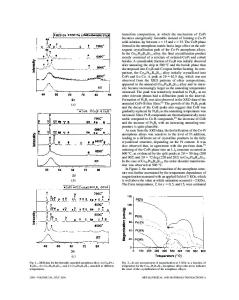Crystallization Kinetics of Fe 80-y V y B 12 Si 8 Amorphous Ribbons
- PDF / 223,341 Bytes
- 5 Pages / 414.72 x 648 pts Page_size
- 10 Downloads / 356 Views
CRYSTALLIZATION KINETICS OF Fe80.yVyBl 2 Si 8 AMORPHOUS RIBBONS P. ALTOZAR, C. VAZQUEZ, L. BAIýOS AND R. VALENZUELA Institute for Materials Research, National University of Mexico, Ap. Postal 70-360, Mexico D.F., 04510, Mexico. ABSTRACT The effects of vanadium in the crystallization kinetics amorphous ribbons Fe 8 0.yVyBl 2 Si8 (0.5 < y < 15) has been investigated by Differential Scanning Calorimetry, by using the Avrami, Kolmogorov-Johnson-Mehl-Avrami, and Calka and Radlinski equations. The addition of vanadium to Fe-B-Si alloys leads to an enhancement of stability against crystallization, as shown by an increase in the effective activation energy for crystallization (Eeff = 3.6eV) and an increase in the temperature for the first crystallization peak, as a function of vanadium content (from 780 to 855K). Results also show that the crystallization mechanism, nucleation rate and dimensionality of growth are constant throughout the crystallization process in the composition range investigated. INTRODUCTION Amorphous alloys in the system Fe-B-Si possess excellent soft ferromagnetic properties, such as an extremely high magnetic permeability and a good frequency stability, which make them useful in many technological applications1, 2 . Their thermal stability, however, has always been a source of concern, since the presence of crystals leads to considerable changes in magnetic properties 3 . In this paper, we present an investigation of the effects of vanadium on the crystallization kinetics of Fe 8 o_yVyBl 2 Si 8 amorphous ribbons, by using the Avrami, Kolmogorov-Johnson-Mehl-Avrami (KJMA), and Calka and Radlinski equations. Vanadium results in an increased stability since the temperature of the first crystallization peak increases. EXPERIMENTAL PROCEDURE Amorphous ribbons in the system Fe 80 .yVyBl 2 Si8 with 0.5
Data Loading...











